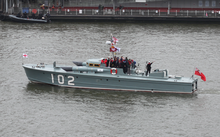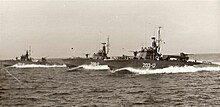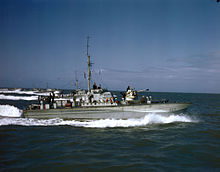Motor torpedo boat: Difference between revisions
Andy Dingley (talk | contribs) WP:BURDEN. If you're adding text claiming that the name was derived from diesel MTBs, you get to show proof they existed at that time. Undid revision 942257745 by Wikiuser100 (talk) |
Wikiuser100 (talk | contribs) Undid revision 942257950 by Andy Dingley (talk)Andy, let's not do this. I am NOT making that claim. I merely added the fuel that a previous inclusion in the lead used. YOU ARE MAKING A CLAIM - the BURDEN is on YOU to establish that MTB *only* refers to "gasoline" torpedo boats, not the generic class as described in the lead. Don't revert this. You understand plain English. |
||
| Line 6: | Line 6: | ||
[[File:Tsqd914.jpg|thumb|right|Israeli MTB formation, ''circa'' 1967]] |
[[File:Tsqd914.jpg|thumb|right|Israeli MTB formation, ''circa'' 1967]] |
||
A '''motor torpedo boat''' is a fast [[torpedo boat]], especially of the mid 20th century. The ''motor'' in the designation, referring to the use of [[petrol engine]] |
A '''motor torpedo boat''' is a fast [[torpedo boat]], especially of the mid 20th century. The ''motor'' in the designation, referring to the use of either [[petrol engine|petrol]] or [[diesel]] engines, distinguishes them from the majority of other naval craft of the era, that used [[steam turbine]]s or [[steam engine|reciprocating steam engine]]s. |
||
The designation is generally used for the [[Royal Navy]] (RN) and [[Royal Canadian Navy]] boats, and is abbreviated to "MTB". During the [[World War II|Second World War]], the [[US Navy]] built several classes of [[PT boat]], whose [[hull classification symbol]] "PT" stood for "patrol, torpedo". |
The designation is generally used for the [[Royal Navy]] (RN) and [[Royal Canadian Navy]] boats, and is abbreviated to "MTB". During the [[World War II|Second World War]], the [[US Navy]] built several classes of [[PT boat]], whose [[hull classification symbol]] "PT" stood for "patrol, torpedo". |
||
Revision as of 16:25, 23 February 2020
This article needs additional citations for verification. (March 2013) |


A motor torpedo boat is a fast torpedo boat, especially of the mid 20th century. The motor in the designation, referring to the use of either petrol or diesel engines, distinguishes them from the majority of other naval craft of the era, that used steam turbines or reciprocating steam engines.
The designation is generally used for the Royal Navy (RN) and Royal Canadian Navy boats, and is abbreviated to "MTB". During the Second World War, the US Navy built several classes of PT boat, whose hull classification symbol "PT" stood for "patrol, torpedo".
German motor torpedo boats of the Second World War were called S-boote (Schnellboote, "fast boats") by the Kriegsmarine and "E-boats" by the Allies. Italian MTBs of this period were known as Motoscafo Armato Silurante ("MAS boats", torpedo armed motorboats). French MTBs were known as vedettes lance torpilles ("torpedo-launching fast boats"). Soviet MTBs were known as торпедные катеры (torpyedniye katyery; "torpedo cutters", often abbreviated as TKA). Romanian MTBs were known as vedete torpiloare ("torpedo fast boats").
After the end of the War in 1945, a number of the Royal Navy's MTBs were stripped and the empty hulls sold for use as houseboats.
History

MTBs were designed for high speed, operating at night, low speed ambush (to keep noise low and to produce no wake) and manoeuvrability on the water; this was to enable them to get close enough to launch their torpedoes at enemy vessels. With no significant armour, the boats relied upon surprise and their agility at high speed to avoid being hit by gunfire from bigger ships.
The British and Italian navies started developing such vessels in the early 20th century, shortly before the beginning of the First World War. Italian MAS boats were comparatively small, at 20-30 tons displacement. MAS 15 was the only motor torpedo boat in history to sink a battleship, the Austro-Hungarian vessel Szent István in 1918.
British torpedo boats of the First World War were small at only around 15 tons and were known as coastal motor boats. In the Second World War, British MTBs were operated by Coastal Forces. A similar size boat with a different role in the Second World War was the BPB 63 ft (19 m) high-speed launch used by the RAF for air-sea rescue operations.[1] The last MTBs in the Royal Navy were the two Template:Sclass2-s of 1958 which were capable of 50 knots (93 km/h).
Specifications
Many boats were designated MTBs. A variety of designs were adopted and built. For instance, a 55 ft (17 m) type, capable of 40 kn (46 mph; 74 km/h), was shown in 1930.[2]
Vosper private venture boat
The Vosper private boat was designed by Commander Peter Du Cane CBE, the managing director of Vosper Ltd, in 1936. She was completed and launched in 1937. She was bought by the Admiralty and taken into service with the Royal Navy as MTB 102.
- Length: 68 ft (21 m)
- Beam: 19 ft 9 in (6.02 m)
- Draft: 3 ft 9 in (1.14 m),
- Powerplant: 3 Isotta Fraschini 57-litre petrol engines
- Power: 3,300 hp (2,500 kW; 3,300 PS)
- Speed: 48 kn (55 mph; 89 km/h) (light), 43 kn (49 mph; 80 km/h) (full load)
- Crew: 2 officers, 10 men.
- Armament:
- Two 21 in (533 mm)[citation needed] torpedo tubes (depth charges, machine guns and 20mm Oerlikon were trialled on her)
MTB 102 was the fastest wartime British naval vessel in service. She was at Dunkirk for the evacuation and carried Winston Churchill and Dwight Eisenhower when they reviewed the fleet before the Invasion of Normandy.
British Power Boat 60 ft MTB
They were based on the British Power Boat rescue craft and were originally designed for the Royal Air Force but reduced to 60 ft (18 m) in length. They could carry two 18-inch (457 mm) torpedoes and achieve a maximum speed of 33 kn (38 mph; 61 km/h). The Royal Navy ordered their first (of a total of 18) in 1936. These entered service as MTB numbers 1 to 12 and 14 to 19. In the early days of the war, they were painted with different numbers and photos distributed to the press to give the impression the Royal Navy had more than they actually did. One photo was sent to the American monthly Popular Science showing the number twenty-three. [3]
Vosper 70 ft MTB
Although various boat lengths were produced by Vosper for the Royal Navy, the "70 ft" boat was produced from 1940. The design was produced with modifications as MTBs 31-40, 57-66, 73-98, 222-245, 347-362, 380-395 and 523-537.
Using three Packard V1-12 marine engines, they were capable of around 37 kn (43 mph; 69 km/h). Early models carried two 21-inch (533 mm) torpedo tubes, two 0.50 in (13 mm) machine guns and two 0.303 in (7.7 mm) machine guns. They could also carry four depth charges.
The Vosper 70 was also used in other navies, such as Romania's, which acquired three in 1939, with NMS Viscolul the lead ship of the class.
Vosper types 1 and 2
Between 1943 and 1945, two Vosper designs appeared, the "Vosper type I 73ft" and the type II.
Vosper type I
- Length: 73 ft (22 m)
- Engine: 3 Packard 12M engines for a total of 4,200 hp
- Speed: 40 knots (74 km/h)
- Range: 470 nmi (870 km) at 20 knots (37 km/h)
- Displacement: 47 t
- Armament:
- Four 18-inch (457 mm) torpedo tubes
- Oerlikon 20 mm cannon
- Two 0.303 in Vickers K machine guns (optionally two Vickers .50 machine guns)
- Crew: 13
Vosper type II
This design remained in use after the war.
- Length 73 ft (22 m)
- Engine 4,200 hp
- Speed 40 knots (74 km/h)
- Range 480 nmi (890 km) at 20 knots (37 km/h)
- Displacement 49 t
- Armament
- Crew 13
Canadian MTBs

These boats were used by the Royal Canadian Navy 29th MTB Flotilla. Originally designed as motor gun boats (MGBs), carrying a 6-pounder (57mm, 2.24 inch) to engage enemy small craft, they were re-designated MTBs.
Scott-Paine type G 70 foot boat
- Manufacturer: British Power Boats, Hythe
- Displacement: 55 tons
- Overall length: 72 ft 6 inches (21 m)
- Breadth: 20 ft 7 inches (6.3 m)
- Draught: 5 ft 8 inches (1.7 m)
- Maximum speed: 38–41 kn (44–47 mph; 70–76 km/h) (new)
- Armament:
- auto-loading QF 6-pounder (57mm, 2.24 inch) gun
- Two 21-inch (533 mm) torpedo tubes (two torpedoes)
- .303 or .50 Vickers machine guns
- 20mm Oerlikon or 40 mm Bofors gun
- Powerplant – three Rolls-Royce or Packard 14M supercharged V-12 engines
three shafts - Power – 3,750 hp total
- Range – 140 nmi (260 km) radius of action at 25 kn (29 mph; 46 km/h)[5]
Post-war usage
After the end of World War II a number of Royal Navy vessels were stripped and sold for use as houseboats. These included MGBs as well as MTBs. Many of these were moored in Langstone Harbour, Littlehampton, Hayling Island and Wootton Creek, although most have now disappeared from these locations. More MTB houseboats can be found at Shoreham-by-Sea (West Sussex), Cobden Bridge (Southampton) and Bembridge (Isle of Wight).[6]
See also
- Battle of Rumani Coast – battle involving MTBs
- Coastal Forces of the Royal Navy
- Fairmile D motor torpedo boat – British "dog boats"
- Fast attack craft
- E-boat
- HNoMS Nasty
- Motor Launch
- Swift boat
- United States Nasty-class patrol boat
Notes
- ^ RAF Air Sea Rescue 1918–1986. Pen and Sword Aviation. 2013. p. 196. ISBN 9781473817449.
{{cite book}}: Cite uses deprecated parameter|authors=(help) - ^ "Midget Torpedo Boat Has Forty-Knot Speed" Popular Science, April 1930, p. 38.
- ^ "Fast Mosquito Boats Aid British Navy" Popular Science, December 1939
- ^ An automatic loading version of the 6-pounder anti-tank gun
- ^ "Naval Museum of Manitoba – Canadian Naval History". www.naval-museum.mb.ca.
- ^ Simons, Philip; Hall, Nick (2006). Retired on the River, a Short History of the Houseboats of Shoreham (3rd ed.). World Ship Society, Small Craft Group. p. 3.
References
- British Motor Torpedo Boat 1939–45 by Angus Konstam, Osprey, 2003, ISBN 978-1-84176-500-6
- Lengerer, Hans (2007). "Motor Torpedo Boats of the Imperial Japanese Navy, Part II". Warship International. XLIV (4): 345–358. ISSN 0043-0374.
- Dog Boats at War: A History of the Operations of the Royal Navy D Class Fairmile Motor Torpedo Boats and Motor Gunboats 1939–1945 by L. C. Reynolds and Lord Lewin, Sutton Pubns Inc, 2000, ISBN 978-0-7509-2454-2
External links
- A Short History of HMS St Christopher
- British Military Powerboat Team
- "Midget Torpedo Boat Has Forty-Knot Speed" Popular Science, April 1934
